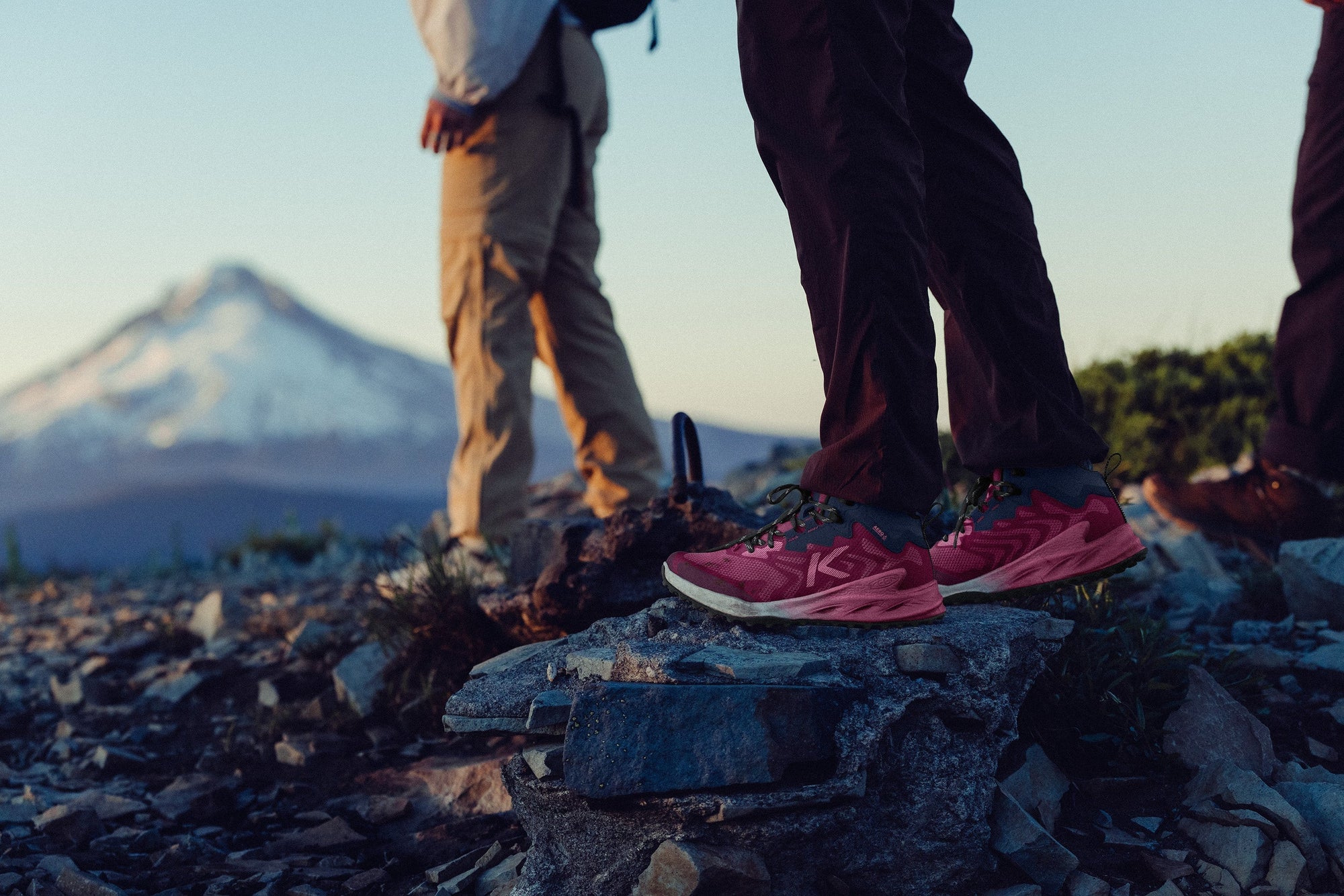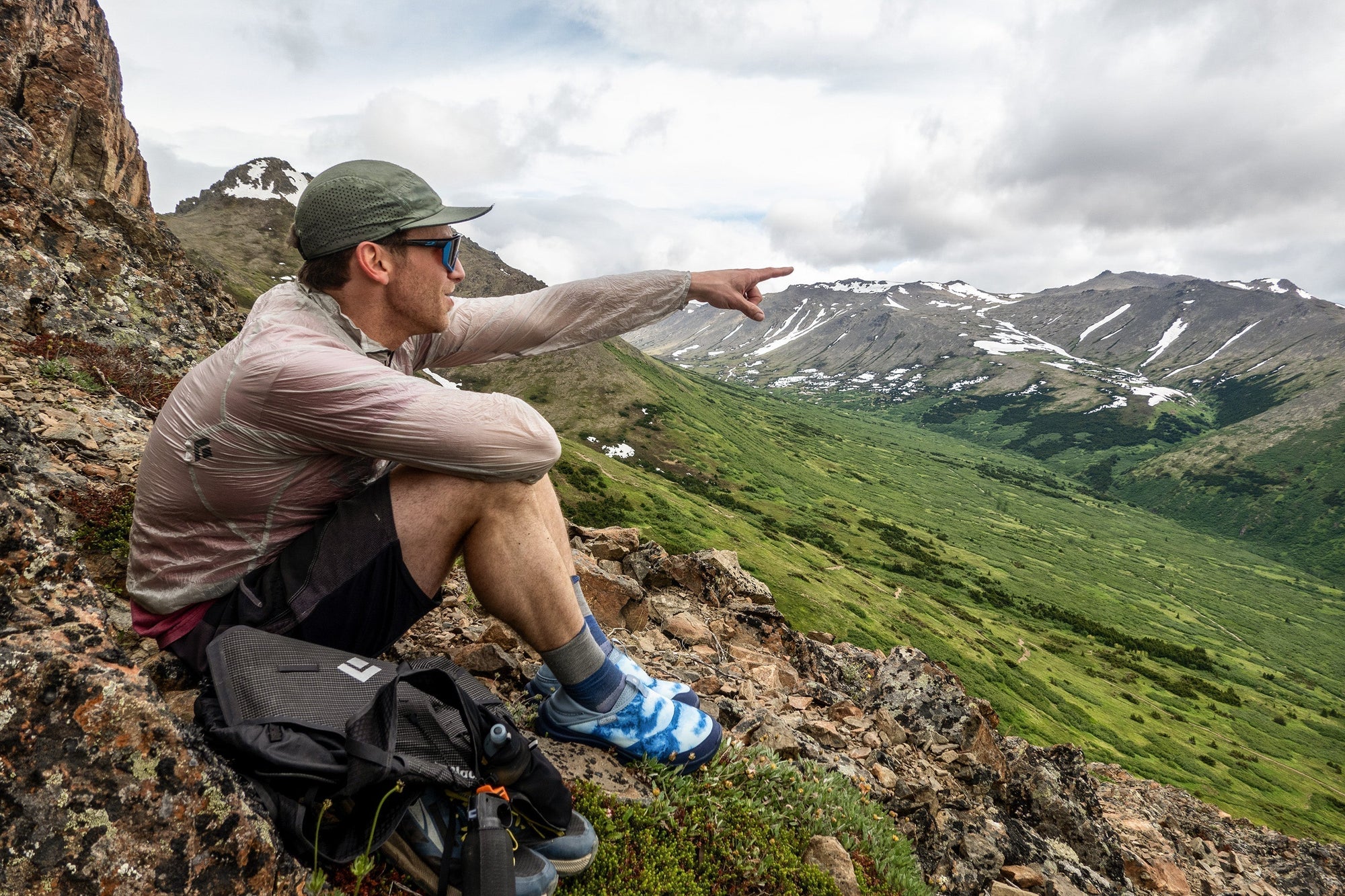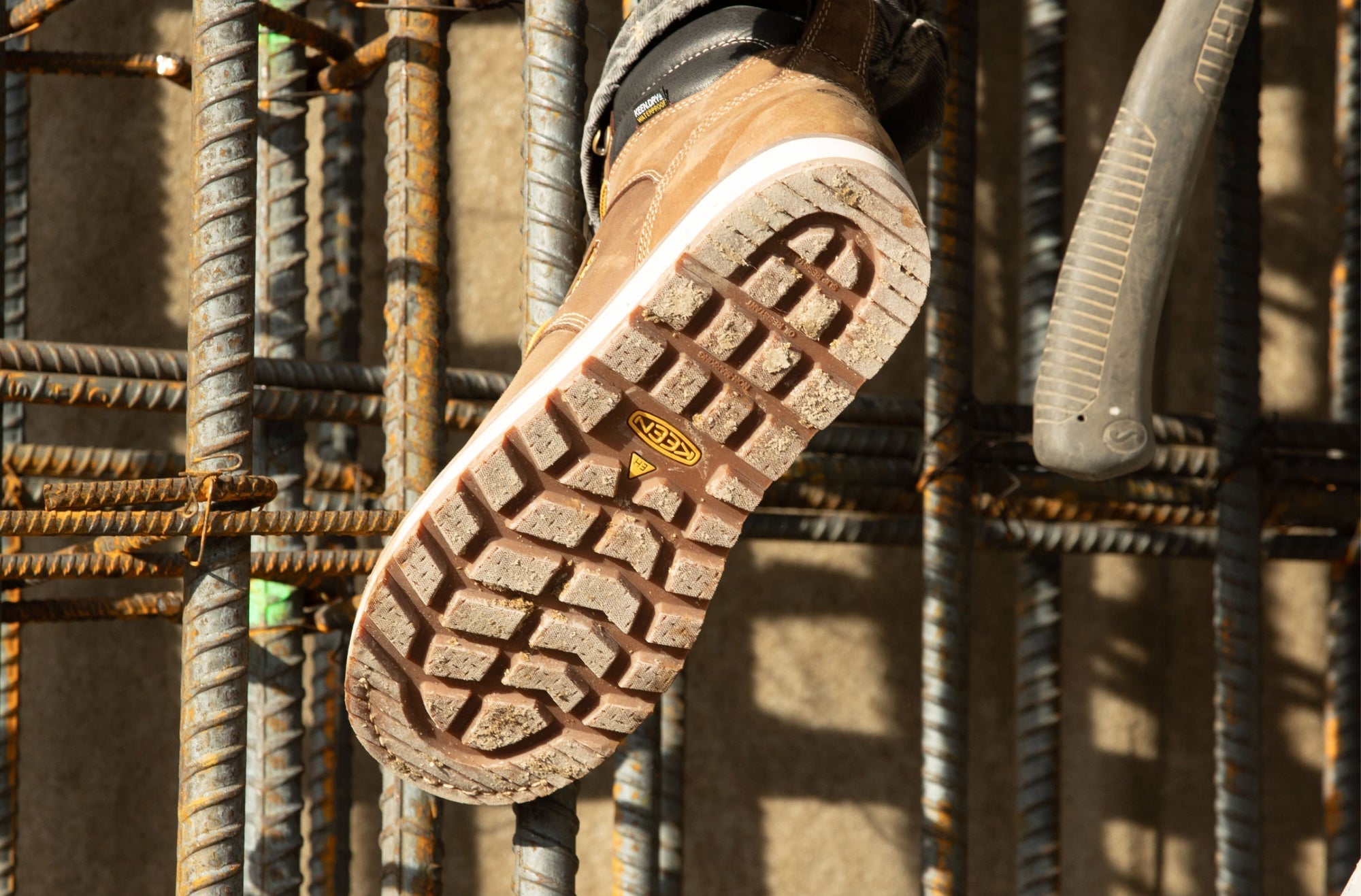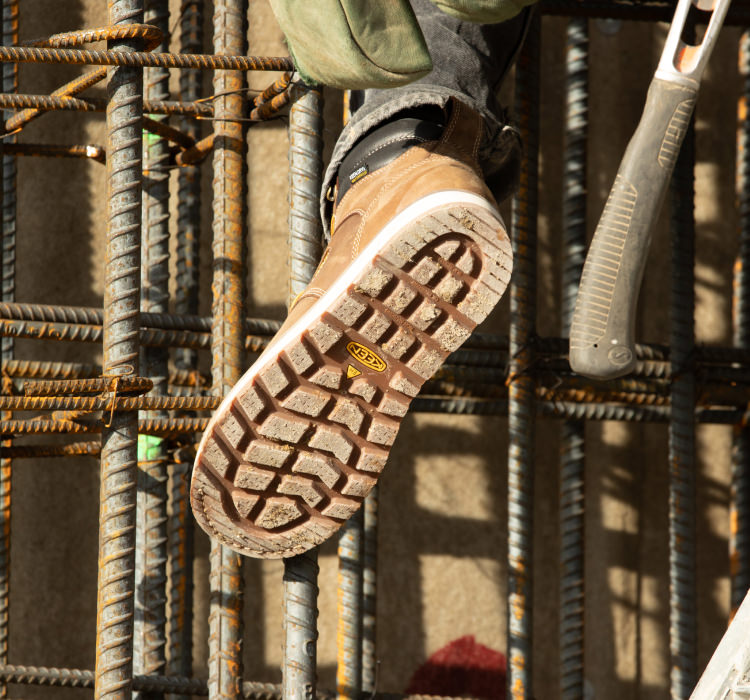The world goes ‘round and ‘round. People connect, ideas are shared, goods are bought, goods are sold (and then hopefully shared, reused, or recycled). And in this whole big cycle of consumption, it takes all of us to close the loop and make a positive impact.
And that’s exactly how the new collection of Harvest bags came to be.
The twice-upcycled fabric threads used to make these bags started out as blue jeans and second-hand clothing before becoming sacks filled with coffee beans. They have been “baton-passed” through many hands between Guatemala City, the volcanic hills of Central America, and the West Coast of the United States.
And it all started with a typical morning cup of coffee in Portland, Oregon.

Step 1: Partnering With Nossa Familia Coffee
KEEN employee Michael Leoniak rolled into his go-to Portland coffee shop, Nossa Familia, before work and noticed a pile of leftover coffee sacks behind the counter.
“We’re on a constant hunt for materials,” Michael says, adding that KEEN’s Harvest collection began 10 years ago with a mission of rethinking how we source materials with a focus on reusing and repurposing where possible. “As soon as I saw the fabric, I said, ‘That’s a great material. These things are perfect for the Harvest collection at KEEN.’”
Nossa Familia had been receiving the upcycled fabric sacks for a few months from their two main coffee growers in Guatemala—De La Gente and Finca San Jerónimo Miramar—and they were thrilled about collaborating with us to find another outlet to continue the upcycling chain.
Just as we have a long history of resourcefulness and finding smart ways to use upcycled materials, Nossa responsibly sources its beans using a direct trade model, developing deeply rooted relationships with its coffee growers to bring customers closer to the source of coffee and give coffee farmers better prices for their beans. We’re both all about putting our values in motion to make the world better while making better products.

"I'm happy to see the bags becoming useful in other things for people than just a means of conveyance of green coffee to import," says Rob Hoos, Director of Coffee at Nossa Familia, adding that they bring in about 8 containers, or roughly 2,000 bags of coffee, in these upcycled sacks every year. "We have a lot of waste in our industry still. To see our industry start taking more of a grip on the actual waste stream is super important."
Step 2: Helping Coffee Farmers in Guatemala

Pretty quickly we realized that upcycling the fabric waste was about so much more than just giving materials a new life. It was also playing a part in giving coffee farmers in Guatemala a better life, too.
That’s because De La Gente, one of the two coffee growers using the upcycled coffee bean sacks, is a non-profit organization in Antigua, Guatemala, that works with small-scale coffee farmers to create economic opportunities that improve the quality of life for their families and communities.

One of the main things that De La Gente does is teach these farmers how to grow and process their coffee—from harvested cherry to ready-to-roast bean—so they earn more. For example, by drying and milling the beans themselves, they can export directly to specialty roasters like Nossa Familia (or roast the beans themselves and package for local sales), instead of selling the cherries to large coffee processors in Guatemala for much, much less money.
"Pretty quickly we realized that upcycling the fabric waste was about so much more than just giving materials a new life. It was also playing a part in giving coffee farmers in Guatemala a better life, too."
Add to that the increased income from the direct trade model used by Nossa (better than fair trade), and these farmers are able to invest in the education, healthcare, housing, and nutrition needed for healthy and thriving communities. Marta Salazar is one of those farmers. She got a micro financing loan through De La Gente and is one of the first women in the region to own coffee-producing land and export her own coffee.

"When I joined I didn't know anything about coffee, I didn’t even have any plants," Marta says. "One of the ways that the co-operative has helped us is to teach us how we can work the coffee. It is something precious, that I can experience as a woman. We have learned everything about fieldwork.
"Now there is always something to eat in the house thanks to the work we do with coffee," she says.
Step 3: Eliminating Fabric Waste in Landfills

Elsewhere in Guatemala, the upcycled coffee sacks are pulling tons of waste out of landfills, thanks to The New Denim Project in Guatemala City, where Arianne Engelberg and her dad, Jaime, have been creating home textiles since her grandfather started the company in 1955. In recent years, they’ve noticed an uptick in second-hand clothing waste being imported into Guatemala—predominantly Americans’ unwanted bargain fashion. All but 15 percent is resold, creating millions of pounds of fabric waste destined for landfills every month. Add to that all the leftover cuts of denim from Guatemalan textile factories that make jeans for the U.S. market, and Arianne saw an opportunity to close the loop.
“[Fabric] is not a disposable product,” Arianne says. “It shouldn’t be.”

Ten years ago, she and her dad began experimenting with ways to reuse all this pre-consumer denim and post-consumer clothing waste. It took them two years to perfect the process that breaks down the fabric, and blends the recycled short fibers with long-fiber thread that can be used to create new textile products.
"Upcycling is a project that is going to take all of us, all of the time, and that’s the point. So we need each other to close the loop eternally on these materials, and create beautiful products from these that can be reused over and over and over again. And eliminate completely the concept of waste."
“It’s crazy to see the massive amounts that leave to the U.S. as first-hand clothing and come back as second-hand clothing,” she says, explaining that a lot of the clothing is made in Guatemala in the first place. “It’s really refreshing and inspiring for us. It gives us a higher purpose.”
Step 4: Thinking Sustainably About Everything

Arianne got the idea to make coffee sacks using her upcycled fabric after chatting with friends Gina and Giorgio, fifth-generation coffee and dairy farmers at Finca San Jerónimo Miramar in southern Guatemala. They learned about what Arianne was doing and thought it would be a more sustainable sack than traditional jute sacks they had been using. (It turns out it also has a softer touch—an added benefit for the workers who load and unload the heavy sacks.)

Their farm is all about caring for the land and the people who work for them, and letting nothing go to waste. Case in point: virtually all organic waste on the farm is composted and spread back on the land. The compost system includes paper from the office, manure from the cows, hay, sawdust, cardboard, and coffee husks. They have even educated workers and residents about separating personal organic waste that can be composted. The New Denim Project also sends its organic waste to be mixed in—all the cotton seed, leaves, and debris that are removed from dirty virgin cotton.
"Our ecologist looks at compost as a probiotic," Giorgio says, adding that they plan to spread about 800 tons of it on their volcanic, coffee-growing slopes. "It's full of important nutrients that the plants need."
As you tour Finca San Jerónimo’s lush fields, you see sustainable growing practices in action all around you. They’ve planted complementary trees that shade the beans. They’ve even specifically planted fruit trees, so they can feed the workers while they are out on the slopes. They are constantly experimenting with natural pest controls in their lab to avoid the use of chemicals. And they let groundcover grow in the paths between rows to retain water and prevent runoff.
"Most traditional farmers wouldn't want to see all the green between the rows," Gina says. "But it's good for the soil."

The coffee sack was just one more way to do things better. Nossa Familia loved the idea and offered to help absorb the extra cost. And then they told their other main coffee grower in Guatemala, De La Gente, about it. And then the idea continued to spread all the way to Portland.
Step 5: Upcycling Materials a Second Time

Bags of coffee beans from De La Gente and Finca San Jerónimo Miramar travel by container ship to the U.S., arriving in Nossa Familia’s Portland shops. Once emptied, they are sent to KEEN’s local manufacturing partners, where the upcycled fabric is upcycled a second time by being cut and sewn into our latest collection of Harvest bags.
"It’s incredible to be a part of the transformation on such a hands-on level," says Julie Valuskova, KEEN Innovation Designer. "One of the most surprising aspects of this project has been to see just how quickly and efficiently the coffee bags develop into an entirely new, premium style. We thought a lot about the life cycle of the fabrics being used and how to present their journey in a new and elevated way."
For Julie, it's a project that has been as challenging as it has been gratifying.
"Unlike conventional fabrics, the nature of the upcycled woven denim blend lends itself to unravelling and unpredictable shaping,” she says. “To combat this challenge, we used special sewing machines to control the fraying fabric and carefully cut down each coffee bag individually to ensure we could maximize the yield of usable fabric—each one being slightly different."

So, to recap, textile waste became coffee bean sacks that played a role in improving the quality of life for farmers and the environment, and then became a one-of-a-kind bag collection. All thanks to five partners who worked together to share ideas and materials, and their passion for making a difference.
“Upcycling is a project that is going to take all of us, all of the time, and that’s the point,” says Arianne. “So we need each other to close the loop eternally on these materials, and create beautiful products from these that can be reused over and over and over again. And eliminate completely the concept of waste.”
When you purchase a Harvest bag at keenfootwear.com or at one of our KEEN Garage retail locations, you join the circle and close the loop. And if you happen to carry that bag around Portland and stop into Nossa Familia for some coffee… well, you’ve just started that circle going ‘round again.

Take a 3-minute journey from Portland to Guatemala in our short film that shows how these twice-upcycled bags came together.






















